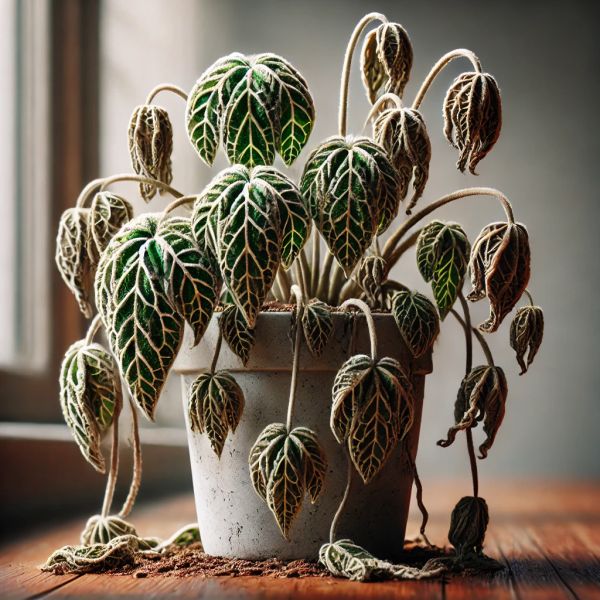Why Is My Plant Wilting or Drooping? Common Causes & How to Fix It
Wilting or drooping leaves can be a sign of distress in your plant. Learn the most common reasons behind this issue and how to revive your plant before it's too late.
A plant's leaves or stems may wilt or droop for a variety of reasons, ranging from watering issues to pest infestations and environmental stress. Identifying the underlying cause is essential to restoring your plant's health.

Disclosure: This content includes affiliate links, which means we may earn a commission if you click on a link and make a purchase. As an Amazon Associate, we earn from qualifying purchases. This comes at no extra cost to you and helps offset the cost of running Leafwise. Please read our disclaimer for more info.
Common Causes of Wilting or Drooping Plants
1. Underwatering (Drought Stress)
If your plant isn't receiving enough water, it will struggle to maintain its structure, leading to droopy, wilted leaves.
- Symptoms: Leaves appear limp, curled, or wrinkled. Soil feels dry and pulls away from the edges of the pot.
- How to Diagnose: Stick your finger 1–2 inches into the soil. If it's completely dry, your plant likely needs water.
-
How to Fix It:
- Slowly water the plant, ensuring the soil is evenly moistened.
- Establish a regular watering schedule based on your plant's needs.
2. Overwatering (Root Rot)
Too much water can suffocate a plant's roots, preventing them from absorbing oxygen and leading to root rot.
- Symptoms: Leaves feel soft and mushy instead of dry and crispy. Soil stays damp for long periods.
- How to Diagnose: Check the soil—if it's soggy and smells rotten, overwatering is likely the cause.
-
How to Fix It:
- Allow the soil to dry out before watering again.
- If root rot is present, trim off the affected roots and repot in fresh, well-draining soil.
3. Heat Stress
High temperatures and excessive sun exposure can cause plants to lose moisture too quickly, leading to wilting.
- Symptoms: Leaves droop or curl inward. The plant wilts during the hottest part of the day but recovers at night.
- How to Diagnose: If your plant wilts only in direct sunlight but perks up in the shade, it's likely heat stress.
-
How to Fix It:
- Move the plant to a cooler, shaded location if possible.
- Water in the early morning to help it retain moisture.
4. Transplant Shock
Repotting or moving a plant to a new environment can cause temporary wilting as it adjusts.
- Symptoms: Wilting or drooping shortly after repotting or relocation.
- How to Diagnose: If you recently repotted the plant or moved it to a new location, transplant shock is likely.
-
How to Fix It:
- Keep the plant well-hydrated but avoid overwatering.
- Reduce direct sunlight exposure for a few days to let it recover.
5. Pests (Sap-Sucking Insects)
Insects like aphids, spider mites, and thrips feed on plant sap, leading to drooping and overall weakness.
- Symptoms: Leaves wilt or become deformed. Fine webbing on the plant (spider mites). Sticky residue (honeydew) on leaves.
- How to Diagnose: Inspect the undersides of leaves for tiny insects or sticky residue.
-
How to Fix It:
- Wash the plant with a strong stream of water. A good nozzle attachment can help with this.
- Use insecticidal soap or neem oil to eliminate pests.
6. Nutrient Deficiency
A lack of key nutrients, particularly potassium or nitrogen, can cause a plant to weaken and wilt.
- Symptoms: Wilting along with yellowing or browning leaves. Poor overall growth.
- How to Diagnose: If wilting is accompanied by discoloration or stunted growth, a nutrient deficiency may be to blame.
-
How to Fix It:
- Apply a balanced liquid fertilizer to provide essential nutrients.
Preventing Wilting and Drooping
- Water Correctly: Adjust watering frequency based on the plant's species and environment.
- Provide Proper Drainage: Use well-draining soil and pots with drainage holes.
- Avoid Extreme Temperatures: Protect plants from excessive heat or cold drafts.
- Check for Pests Regularly: Inspect plants for signs of insects and treat infestations promptly.
- Fertilize as Needed: Provide essential nutrients during the growing season.
Need More Help?
If you're still unsure about why your plant is wilting, try the Leafwise Plant Health Diagnosis Tool for a personalized assessment based on your plant's symptoms.
